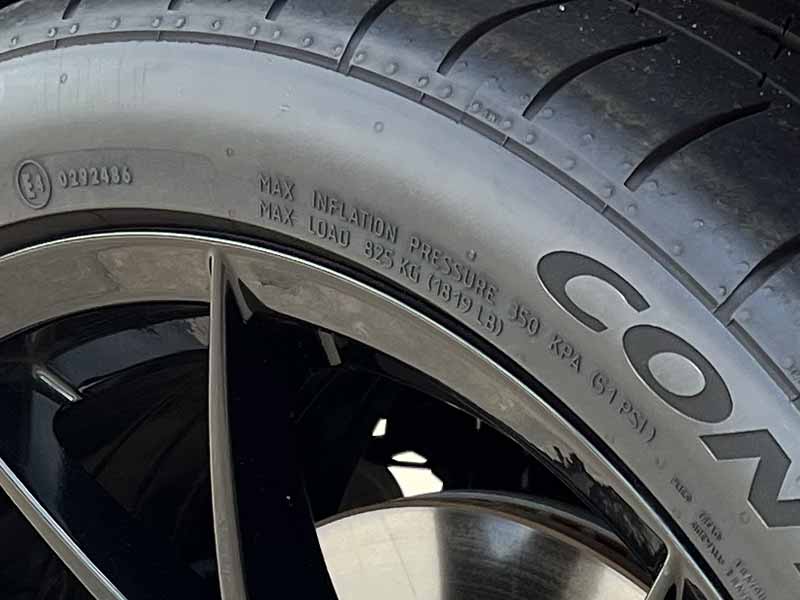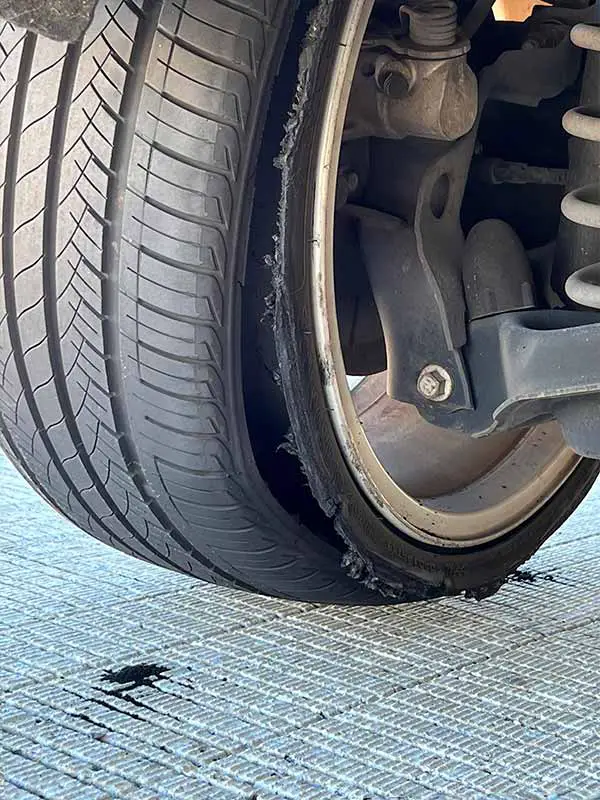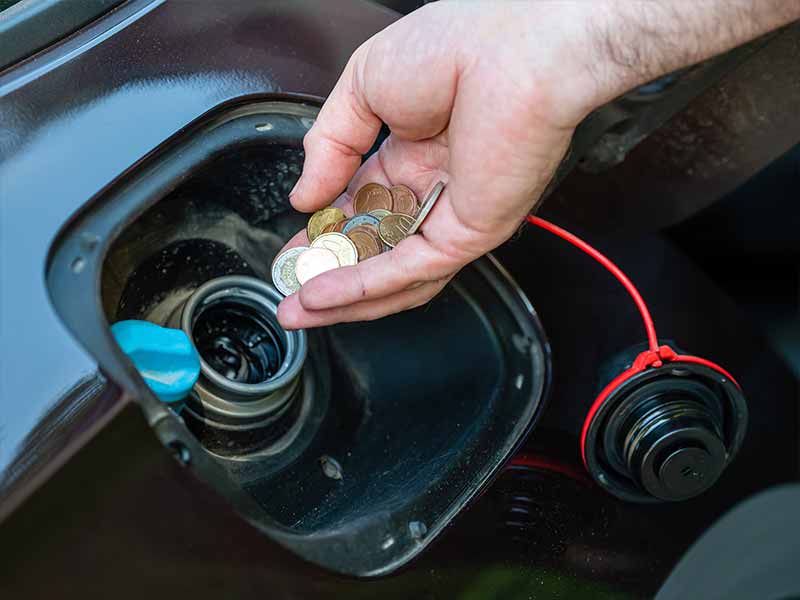What happens when you have over inflated tires? The effects can be subtle yet significant, impacting everything from the comfort of your ride to your vehicle’s fuel efficiency.
Overinflated Tires Symptoms
Overinflated tires are those filled with air beyond the recommended PSI, leading to a rougher ride, uneven tire wear, and potential safety risks.
In this article, we’ll take a look at the symptoms of over inflated tires, debunk common misconceptions, explore the impact on fuel economy, and contrast the effects with underinflated tires.
Let’s take a closer look.
Understanding Overinflation
Overinflation is when there’s too much air in a tire. Think of it like blowing up a balloon. If you put in just the right amount of air, it’s perfect. But if you keep blowing and blowing, it gets too full and might pop. Tires are a bit like that. They need just the right amount of air to work best.
What is the Right Amount of Air?
Every tire has a recommended amount of air, which we call “PSI” (Pounds per Square Inch). This number tells us how much air should be inside the tire. You can usually find this number on the side of the tire or in the car’s manual.
- Why is this number important?
- The right PSI makes sure the tire comes into contact with the road in evenly. This helps the car drive smoothly and safely.

How Can You Tell If There’s Too Much Air?
When a tire has too much air, it doesn’t contact the road the way it should. Only the middle part of the tire might touch the road, while the sides stay up in the air. This can make the ride feel bumpy and not very comfortable.
Why Shouldn’t We Overinflate?
Putting too much air in a tire can cause problems:
- Wear and Tear: The middle part of the tire wears out faster because it’s the only part touching the road.
- Less Grip: The tire might not grip the road as well, especially when it’s wet. This can make driving risky.
- Possible Damage: Just like a balloon, a tire can get damaged if it has too much air. It might even burst if it hits something sharp.
When I’m working on tires, I always make sure to use a good air pressure gauge. It helps me put in the right amount of air. And if I think there’s too much air, I let some out until it’s just right.
Checking and Adjusting Air Pressure
It’s a good idea to check your tire’s air pressure regularly. Here’s how you can do it:
- Get an air pressure gauge. You can find these at car stores.
- Remove the cap from the tire’s air valve.
- Push the gauge onto the valve and read the number.
- If the number is higher than the recommended PSI, let some air out. If it’s lower, add some air.

Symptoms of Overinflated Tires
When there’s too much air in a tire, it can cause some problems. These problems are like warning signs. They tell us that something isn’t right. Here are some of the main signs that a tire might have too much air.
1. An Uncomfortable Ride
One of the first things you might notice is that the ride feels bumpy or rough. Instead of a smooth drive, it might feel like you’re going over tiny bumps all the time.
- Why does this happen?
- When a tire has too much air, only the middle part touches the road. The sides don’t touch the road as they should. This makes the ride feel uneven.
I’ve driven cars with overinflated tires, and it’s not comfortable. It feels like the car is hopping on the road. Always check the air if the ride feels too bumpy.
2. Tires Wear Out in the Middle
If you look at the center treads on your tire and see that the tread depth in the middle is wearing out faster than the sides, it might have too much air. The middle part gets used more because it’s the only part touching the road.
3. The Car Loses Traction Easily
When tires have too much air, they might not grip the road well. This can be risky, especially on wet roads. The car might slide or skid more easily causing you to lose control.
4. Tires Look Too Full
Sometimes, you can see that a tire has too much air just by looking at it. It might look too round or bulging in the middle. Don’t expect to be able to look at a tire and tell if it’s inflated to the correct pressure though. Most modern tires can be significantly over or under inflated and look similar.
5. Risk of a Tire Blowout
This is a big one. If a tire has way too much air, it can burst. This is like when a balloon pops because it’s too full. A tire bursting while driving can be very dangerous.

Common Misconceptions and Questions
Tires are a crucial part of our cars, but there’s a lot of information out there. Sometimes, it’s hard to know what’s right and what’s not. Let’s clear up some common questions and misconceptions about overinflated tires.
What Do Overinflated Tires Feel Like?
Many people wonder how to tell if their tires have too much air just by driving. Here’s what you might notice:
- The ride feels bumpy or rough, like you’re constantly going over tiny bumps.
- The car might feel like it’s sliding or not gripping the road well, especially on turns or wet surfaces.
- You probably won’t notice much difference in feel unless you have significantly over inflated tires.
In my years of working with tires, I’ve found that the feel of the ride is often the first clue. If something feels off, it’s worth checking the tire pressure.
Is 40 PSI Too High for Tires?
The right PSI for a tire depends on the tire and the car. Some tires might be okay with 40 PSI, while others might not.
- The best way to know is to check the recommended PSI. This is usually on the side of the tire or in the car’s manual.
- If you’re ever unsure, it’s better to be safe and ask an expert or check the manual.
I’ve come across many cars where the owner thought a certain PSI (such as 40 PSI) was the standard for all tires. Other’s thought the best pressure to use was found on the tire itself. The truth is every vehicle is different. Always go by the vehicle manufacturer’s recommended pressure usually found in the driver’s door jamb or owner’s manual.
Will the Tire Pressure Light Come On If Overinflated?
Most cars have a tire pressure warning light. This light usually comes on if the tire pressure is too low. But it might not always come on if the pressure is too high.
- It’s a good idea to check the tire pressure yourself, even if the light isn’t on.
- Remember, the warning light is just one tool. It’s always best to double-check.
I’ve seen cars where the light didn’t come on, but the tires were clearly overinflated. Trusting your instincts and checking regularly can save a lot of trouble.

The Impact of Tire Pressure on Fuel Economy
Fuel economy is all about how efficiently your car uses fuel. Believe it or not, the amount of air in your tires can affect this. Let’s explore how tire pressure and fuel economy are connected.
How Does Tire Pressure Affect Fuel Economy?
When tires have the right amount of air, they roll on the road smoothly. This means the car doesn’t have to work as hard, and it uses fuel more efficiently. But if the tires have too much or too little air, things change.
- Too Much Air: Overinflated tires might touch the road only in the middle. This can reduce the tire’s grip and make the car work harder, using more fuel.
- Too Little Air: Underinflated tires have more of their surface touching the road. This can create drag and make the car use more fuel.
Benefits of Proper Tire Pressure
Maintaining the right tire pressure isn’t just about fuel economy. It has other benefits:
- Better Handling: The car responds better to turns and stops.
- Longer Tire Life: Tires wear out evenly and last longer.
- Safer Driving: Properly inflated tires reduce the risk of accidents.

Underinflated Tires
Underinflated simply means that a tire doesn’t have enough air. It’s like when a balloon starts to go flat because it’s losing air. When this happens to a tire, the center of the tire isn’t pressed as firmly onto the road and the inner and outer edges of the tire support more of the weight of your car or truck.
Signs of Underinflated Tires
Just like overinflated tires have signs, underinflated tires do too. Here’s what you might notice:
- Flat Appearance: The tire might look squished or flat at the bottom.
- Slower Driving: The car might feel like it’s dragging or not moving as quickly as usual.
- More Fuel Use: The car might use up fuel faster than before.
In my years of working with tires, underinflation is a common issue I see. It’s easy to overlook, but it can have big effects on how a car drives.
Risks of Underinflated Tires
Driving with tires that don’t have enough air can be risky:
- Overheating: Tires can get hot when they’re underinflated, which can lead to damage or a blowout.
- Uneven Wear: The edges of the tire might wear out faster than the middle.
- Reduced Grip: The tire might not grip the road as well, making driving unsafe.
Resources
Below are some links you may find helpful when learning about tires
Final Thoughts
Overinflated tires can lead to an uncomfortable ride, increased wear in the center treads, and even potential blowouts. On the flip side, underinflated tires come with their own set of challenges.
Regularly checking and adjusting your tire pressure ensures a smoother, safer drive and can even save you money on fuel in the long run.
Good luck and happy motoring.




